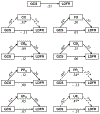Acute pediatric traumatic brain injury severity predicts long-term verbal memory performance through suppression by white matter integrity on diffusion tensor imaging
- PMID: 31134584
- PMCID: PMC6879808
- DOI: 10.1007/s11682-019-00093-9
Acute pediatric traumatic brain injury severity predicts long-term verbal memory performance through suppression by white matter integrity on diffusion tensor imaging
Abstract
Mediation analysis was used to investigate the role of white matter integrity in the relationship between injury severity and verbal memory performance in participants with chronic pediatric traumatic brain injury (TBI). DTI tractography was used to measure fractional anisotropy (FA) within the corpus callosum, fornix, cingulum bundles, perforant pathways, and uncinate fasciculi. Injury severity was indexed using Glasgow Coma Scale (GCS) scores obtained at the time of the injury. Verbal memory was measured by performance on the long-delay free recall (LDFR) trial of the California Verbal Learning Test-Children's version. Participants were between the ages of 10-18 and included 21 children with TBI (injured before age 9) and 19 typically-developing children (TDC). Children with TBI showed lower FA across all pathways and poorer LDFR performance relative to TDC. Within the TBI group, mediation analysis revealed neither a significant total effect of GCS on LDFR nor significant direct effects of GCS on LDFR across pathways; however, the indirect effects of GCS on LDFR through FA of the corpus callosum, left perforant pathway, and left uncinate fasciculus were significant and opposite in sign to their respective direct effects. These results suggests that the predictive validity of GCS for LDFR is initially suppressed by the substantial variance accounted for by FA, which is uncorrelated with GCS, and the predictive validity of GCS increases only when FA is considered, and the opposing path is controlled. These findings illustrate the complex associations between acute injury severity, white matter pathways, and verbal memory several years following pediatric TBI.
Keywords: Diffusion tensor imaging tractography; Fractional anisotropy; Injury severity; Pediatric traumatic brain injury; Verbal memory.
Conflict of interest statement
Conflicts of interest
Hannah M. Lindsey, Sanam Jivani Lalani, Jonathan Mietchen, Shawn D. Gale, Elisabeth A. Wilde, Jessica Faber, Marianne MacLeod, Jill V. Hunter, Zili D. Chu, Mary E. Aitken, Linda Ewing-Cobbs, and Harvey S. Levin declare that they have no conflict of interest.
Figures


Similar articles
-
Relevance of neuroimaging for neurocognitive and behavioral outcome after pediatric traumatic brain injury.Brain Imaging Behav. 2018 Feb;12(1):29-43. doi: 10.1007/s11682-017-9673-3. Brain Imaging Behav. 2018. PMID: 28092022 Free PMC article.
-
Connectome mapping with edge density imaging differentiates pediatric mild traumatic brain injury from typically developing controls: proof of concept.Pediatr Radiol. 2020 Oct;50(11):1594-1601. doi: 10.1007/s00247-020-04743-9. Epub 2020 Jun 30. Pediatr Radiol. 2020. PMID: 32607611 Free PMC article.
-
White matter microstructure predicts longitudinal social cognitive outcomes after paediatric traumatic brain injury: a diffusion tensor imaging study.Psychol Med. 2018 Mar;48(4):679-691. doi: 10.1017/S0033291717002057. Epub 2017 Aug 7. Psychol Med. 2018. PMID: 28780927
-
Relationship between white matter integrity and post-traumatic cognitive deficits: a systematic review and meta-analysis.J Neurol Neurosurg Psychiatry. 2019 Jan;90(1):98-107. doi: 10.1136/jnnp-2017-317691. Epub 2018 Aug 2. J Neurol Neurosurg Psychiatry. 2019. PMID: 30072375
-
The relationship between diffusion tensor imaging findings and cognitive outcomes following adult traumatic brain injury: A meta-analysis.Neurosci Biobehav Rev. 2018 Sep;92:93-103. doi: 10.1016/j.neubiorev.2018.05.023. Epub 2018 May 24. Neurosci Biobehav Rev. 2018. PMID: 29803527 Review.
Cited by
-
A single mild juvenile TBI in male mice leads to regional brain tissue abnormalities at 12 months of age that correlate with cognitive impairment at the middle age.Acta Neuropathol Commun. 2023 Mar 1;11(1):32. doi: 10.1186/s40478-023-01515-y. Acta Neuropathol Commun. 2023. PMID: 36859364 Free PMC article.
-
Longitudinal fixel-based analysis reveals restoration of white matter alterations following balance training in young brain-injured patients.Neuroimage Clin. 2021;30:102621. doi: 10.1016/j.nicl.2021.102621. Epub 2021 Mar 10. Neuroimage Clin. 2021. PMID: 33780865 Free PMC article.
-
Challenges and opportunities for neuroimaging in young patients with traumatic brain injury: a coordinated effort towards advancing discovery from the ENIGMA pediatric moderate/severe TBI group.Brain Imaging Behav. 2021 Apr;15(2):555-575. doi: 10.1007/s11682-020-00363-x. Brain Imaging Behav. 2021. PMID: 32734437 Free PMC article.
-
Accelerated cell cycles enable organ regeneration under developmental time constraints in the Drosophila hindgut.Dev Cell. 2021 Jul 26;56(14):2059-2072.e3. doi: 10.1016/j.devcel.2021.04.029. Epub 2021 May 20. Dev Cell. 2021. PMID: 34019841 Free PMC article.
-
A Preliminary DTI Tractography Study of Developmental Neuroplasticity 5-15 Years After Early Childhood Traumatic Brain Injury.Front Neurol. 2021 Dec 23;12:734055. doi: 10.3389/fneur.2021.734055. eCollection 2021. Front Neurol. 2021. PMID: 35002913 Free PMC article.
References
-
- Adnan A, Crawley A, Mikulis D, Moscovitch M, Colella B, & Green R (2013). Moderate-severe traumatic brain injury causes delayed loss of white matter integrity: Evidence of fornix deterioration in the chronic stage of injury. Brain Inj, 27(12), 1415–1422, doi:10.3109/02699052.2013.823659. - DOI - PubMed
MeSH terms
Grants and funding
LinkOut - more resources
Full Text Sources
Medical

